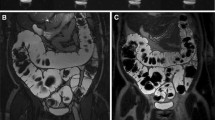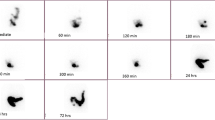Abstract
Objectives
To assess prospectively the agreement of orocaecal transit time (OCTT) measurements by lactulose hydrogen breath test (LHBT) and magnetic resonance imaging (MRI) in healthy subjects.
Methods
Volunteers underwent abdominal 1.5-T MRI using axial and coronal single-shot fast-spin-echo T2-weighted sequences, having fasted and after lactulose ingestion (10 g/125 mL). Imaging and H2 excretion gas-chromatography were performed concurrently every 15 min up to 180 min. MR images were analyzed using semiautomatic segmentation to calculate small bowel gas volume (SBGV) and visually to detect bolus arrival in the caecum. Agreement between MRI- and LHBT-OCTT was assessed.
Results
Twenty-eight subjects (17 men/11 women; mean age ± standard deviation 30 ± 8 years) were evaluated. Two H2 non-producers on LHBT were excluded. OCTT measured by MRI and LHBT was concordant in 18/26 (69 %) subjects (excellent agreement, k = 0.924). Median SBGV was 49.0 mL (interquartile interval 44.1 – 51.6 mL). In 8/26 (31 %) subjects, MRI showed that the lactulose bolus was in the terminal ileum and not the caecum when H2E increased on LHBT. Median OCTT measured by MRI was significantly longer than OCTT measured by LHBT [135 min (120 – 150 min) vs. 127.5 min (105 – 150 min); p = 0.008]. Above baseline levels, correlation between [H2] and SBGV was significant (r = 0.964; p < 0.001).
Conclusions
MRI provides valid measurements of OCTT and gas production in the small bowel.
Key Points
• MRI is a valid technique to measure OCTT.
• Excellent agreement between MRI and LHBT was found.
• Measuring gas production using MRI may provide evidence of small bowel fermentation.






Similar content being viewed by others
References
Suarez FL, Levitt MD (2002) Intestinal gas. In: Feldman M, Friedman LS, Sleisenger MH (eds) Gastrointestinal and liver diseases: pathophysiology/diagnosis/management. WB Sanders Co, Philadelphia, pp 155–163
Azpiroz F, Malagelada J-R (2005) Abdominal bloating. Gastroenterology 129:1060–1078
Lembo A, Ameen VZ, Drossman DA (2005) Irritable bowel syndrome: toward an understanding of severity. Clin Gastroenterol Hepatol 3:717e25
Vanner SJ, Depew WT, Paterson WG et al (1999) Predictive value of the Rome criteria for diagnosing the irritable bowel syndrome. Am J Gastroenterol 94:2912e17
Barbara G, Stanghellini V, Brandi G et al (2005) Interactions between commensal bacteria and gut sensorimotor function in health and disease. Am J Gastroenterol 100:2560e8
Gilmore IT (1990) Orocaecal transit time in health and disease. Gut 31:250–251
Longstreth GF, Thompson WG, Chey WD et al (2006) Functional bowel disorders. Gastroenterology 130:1480–1491
Zhao J, Zheng X, Chu H et al (2014) A study of the methodological and clinical validity of the combined lactulose hydrogen breath test with scintigraphic oro-cecal transit test for diagnosing small intestinal bacterial overgrowth in IBS patients. Neurogastroenterol Motil 26:794–802
Rao SS, Camilleri M, Hasler WL et al (2011) Evaluation of gastrointestinal transit in clinical practice: position paper of the American and European Neurogastroenterology and Motility Societies. Neurogastroenterol Motil 23:8–23
Hasler WL (2003) Lactulose breath testing, bacterial overgrowth, and IBS: just a lot of hot air? Gastroenterology 125:1898e900
Bond JH, Levitt MD (1975) Investigation of small bowel transit time in man utilizing pulmonary hydrogen (H2) measurements. J Lab Clin Med 85:546–555
Rana SV, Malik A (2014) Breath tests and irritable bowel syndrome. World J Gastroenterol 20:7587–7601
Metcalf AM, Phillips SF, Zinsmeister AR et al (1987) Simplified assessment of segmental colonic transit. Gastroenterology 92:40–47
Schwizer W, Steingoetter A, Fox M (2006) Magnetic resonance imaging for the assessment of gastrointestinal function. Scand J Gastroenterol 41:1245–1260
Chaddock G, Lam C, Hoad CL et al (2014) Novel MRI tests of orocecal transit time and whole gut transit time: studies in normal subjects. Neurogastroenterol Motil 26:205–214
Hahn T, Kozerke S, Schwizer W et al (2012) 19F MR imaging golden angle-based capsule tracking for intestinal transit and catheter tracking: initial in vivo experience. Radiology 265:917–925
Worsøe J, Fynne L, Gregersen T et al (2011) Gastric transit and small intestinal transit time and motility assessed by a magnet tracking system. BMC Gastroenterol 11:145
Pimentel M, Lezcano S (2007) Irritable bowel syndrome: bacterial overgrowth - what’s known and what to do. Curr Treat Options Gastroenterol 10:328e37
Vanner S (2008) The small intestinal bacterial overgrowth. Irritable bowel syndrome hypothesis: implications for treatment. Gut 57:1315e21
Pimentel M, Chow EJ, Lin HC (2000) Eradication of small intestinal bacterial overgrowth reduces symptoms of irritable bowel syndrome. Am J Gastroenterol 95:3503e6
Furnari M, Parodi A, Gemignani L et al (2010) Clinical trial: the combination of rifaximin with partially hydrolysed guar gum is more effective than rifaximin alone in eradicating small intestinal bacterial overgrowth. Aliment Pharmacol Ther 32:1000–1006
Gasbarrini A, Corazza GR, Gasbarrini G et al (2009) Methodology and indications of H2-breath testing in gastrointestinal diseases: the Rome Consensus Conference. Aliment Pharmacol Ther 29:1–49
Pimentel M, Chow EJ, Lin HC (2003) Normalization of lactulose breath testing correlates with symptom improvement in irritable bowel syndrome. a double-blind, randomized, placebo-controlled study. Am J Gastroenterol 98:412e19
Jahng J, Jung IS, Choi EJ, Conklin JL, Park H (2012) The effects of methane and hydrogen gases produced by enteric bacteria on ileal motility and colonic transit time. Neurogastroenterol Motil 24:185–190
Yu D, Cheeseman F, Vanner S (2011) Combined oro-caecal scintigraphy and lactulose hydrogen breath testing demonstrate that breath testing detects oro-caecal transit, not small intestinal bacterial overgrowth in patients with IBS. Gut 60:334–340
Parodi A, Sessarego M, Greco A et al (2008) Small intestinal bacterial overgrowth in patients suffering from scleroderma: clinical effectiveness of its eradication. Am J Gastroenterol 103:1257–1262
Gemignani L, Savarino V, Ghio M et al (2013) Lactulose breath test to assess oro-cecal transit delay and estimate esophageal dysmotility in scleroderma patients. Semin Arthritis Rheum 42:522–529
Bennink R, Peeters M, Van den Maegdenbergh V et al (1999) Evaluation of small-bowel transit for solid and liquid test meal in healthy men and women. Eur J Nucl Med 26:1560–1566
Xu HM, Han JG, Na Y, Zhao B, Ma HC, Wang ZJ (2011) Colonic transit time in patient with slow-transit constipation: comparison of radiopaque markers and barium suspension method. Eur J Radiol 79:211–213
Kwiatek MA, Menne D, Steingoetter A et al (2009) Effect of meal volume and calorie load on postprandial gastric function and emptying: studies under physiological conditions by combined fiber-optic pressure measurement and MRI. Am J Physiol Gastrointest Liver Physiol 297:G894–G901
Kwiatek MA, Fox MR, Steingoetter A et al (2009) Effects of clonidine and sumatriptan on postprandial gastric volume response, antral contraction waves and emptying: an MRI study. Neurogastroenterol Motil 21:928-e971
Marciani L, Cox EF, Hoad CL et al (2010) Postprandial changes in small bowel water content in healthy subjects and patients with irritable bowel syndrome. Gastroenterology 138:469–477
Murray K, Wilkinson-Smith V, Hoad C et al (2014) Differential effects of FODMAPs (fermentable oligo-, di-, mono-saccharides and polyols) on small and large intestinal contents in healthy subjects shown by MRI. Am J Gastroenterol 109:110–119
Marciani L (2014) Assessment of gastrointestinal motor functions by MRI: a comprehensive review. Neurogastroenterol Motil 23:399–407
Hao WL, Lee YK (2004) Microflora of the gastrointestinal tract: a review. Methods Mol Biol 268:491–502
Bratten JR, Spanier J, Jones MP (2008) Lactulose breath testing does not discriminate patients with irritable bowel syndrome from healthy controls. Am J Gastroenterol 103:958e63
Cloarec D, Bornet F, Gouilloud S et al (1990) Breath hydrogen response to lactulose in healthy subjects: relationship to methane producing status. Gut 31:300–304
Furnari M, Savarino E, Bruzzone L et al (2012) Reassessment of the role of methane production between irritable bowel syndrome and functional constipation. J Gastrointest Liver Dis 21:157–163
Zhao J, Fox M, Cong Y et al (2010) Lactose intolerance in patients with chronic functional diarrhoea: the role of small intestinal bacterial overgrowth. Aliment Pharmacol Ther 31:892–900
Hammer HF, Santa Ana CA, Schiller LR et al (1989) Studies of osmotic diarrhea induced in normal subjects by ingestion of polyethylene glycol and lactulose. J Clin Invest 84:1056–1062
Acknowledgments
The scientific guarantor of this publication is Luca Maria Sconfienza, MD PhD. The authors of this manuscript declare no relationships with any companies, whose products or services may be related to the subject matter of the article. The authors state that this work has not received any funding. One of the authors has significant statistical expertise. Institutional review board approval was obtained. Written informed consent was obtained from all subjects in this study. Methodology: prospective diagnostic, performed at one institution.
Author information
Authors and Affiliations
Corresponding author
Rights and permissions
About this article
Cite this article
Savarino, E., Savarino, V., Fox, M. et al. Measurement of oro-caecal transit time by magnetic resonance imaging. Eur Radiol 25, 1579–1587 (2015). https://doi.org/10.1007/s00330-014-3575-1
Received:
Revised:
Accepted:
Published:
Issue Date:
DOI: https://doi.org/10.1007/s00330-014-3575-1




